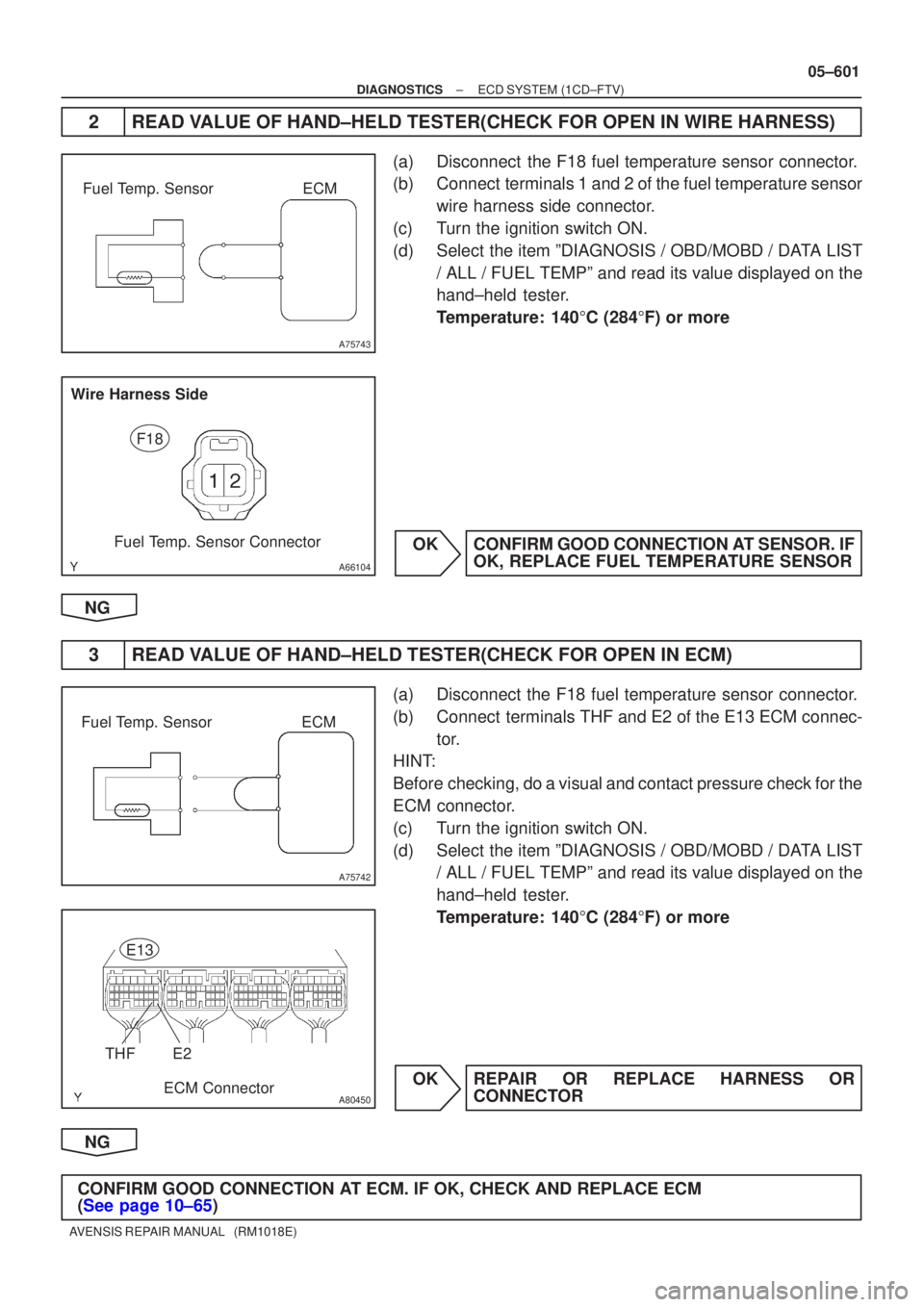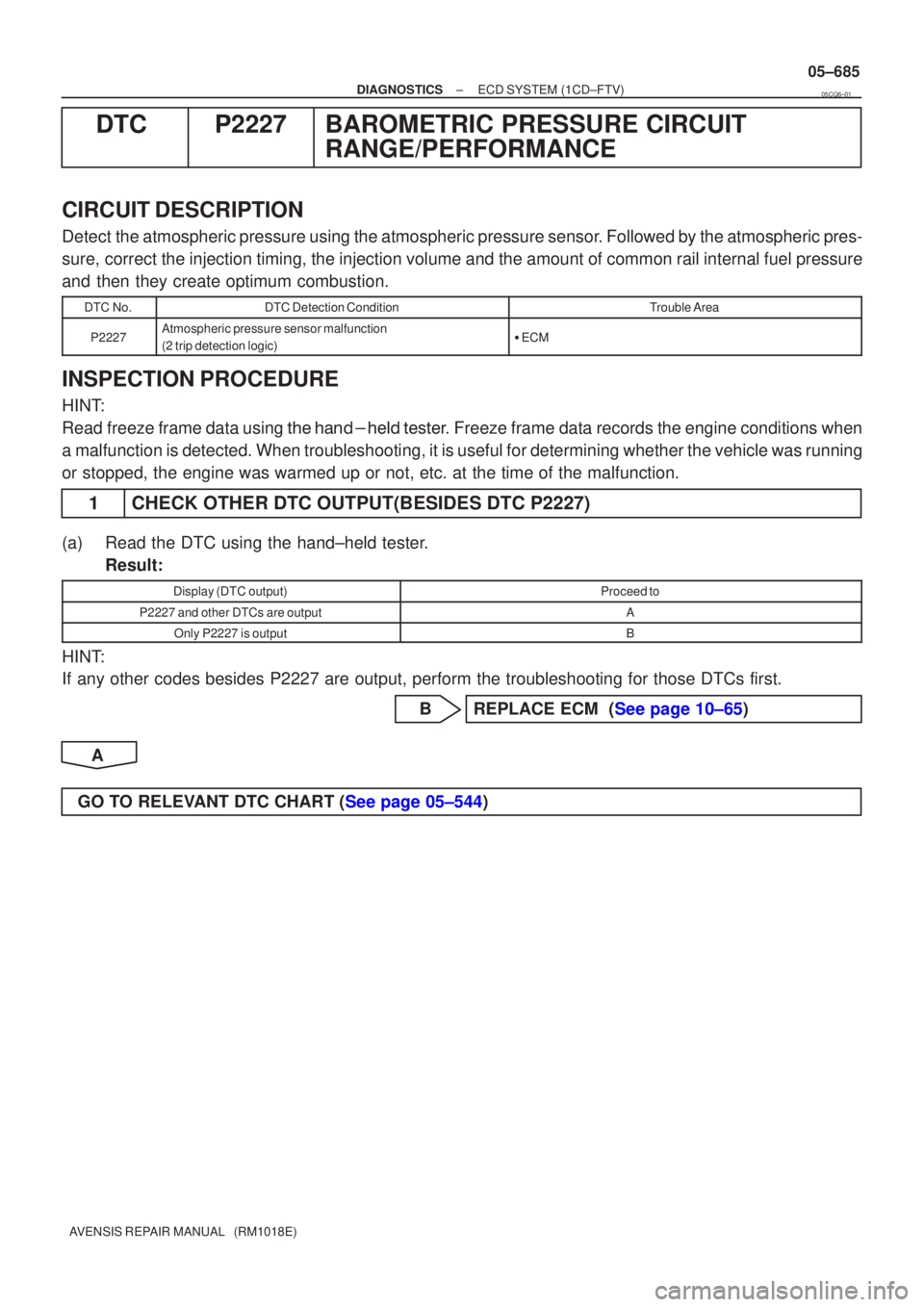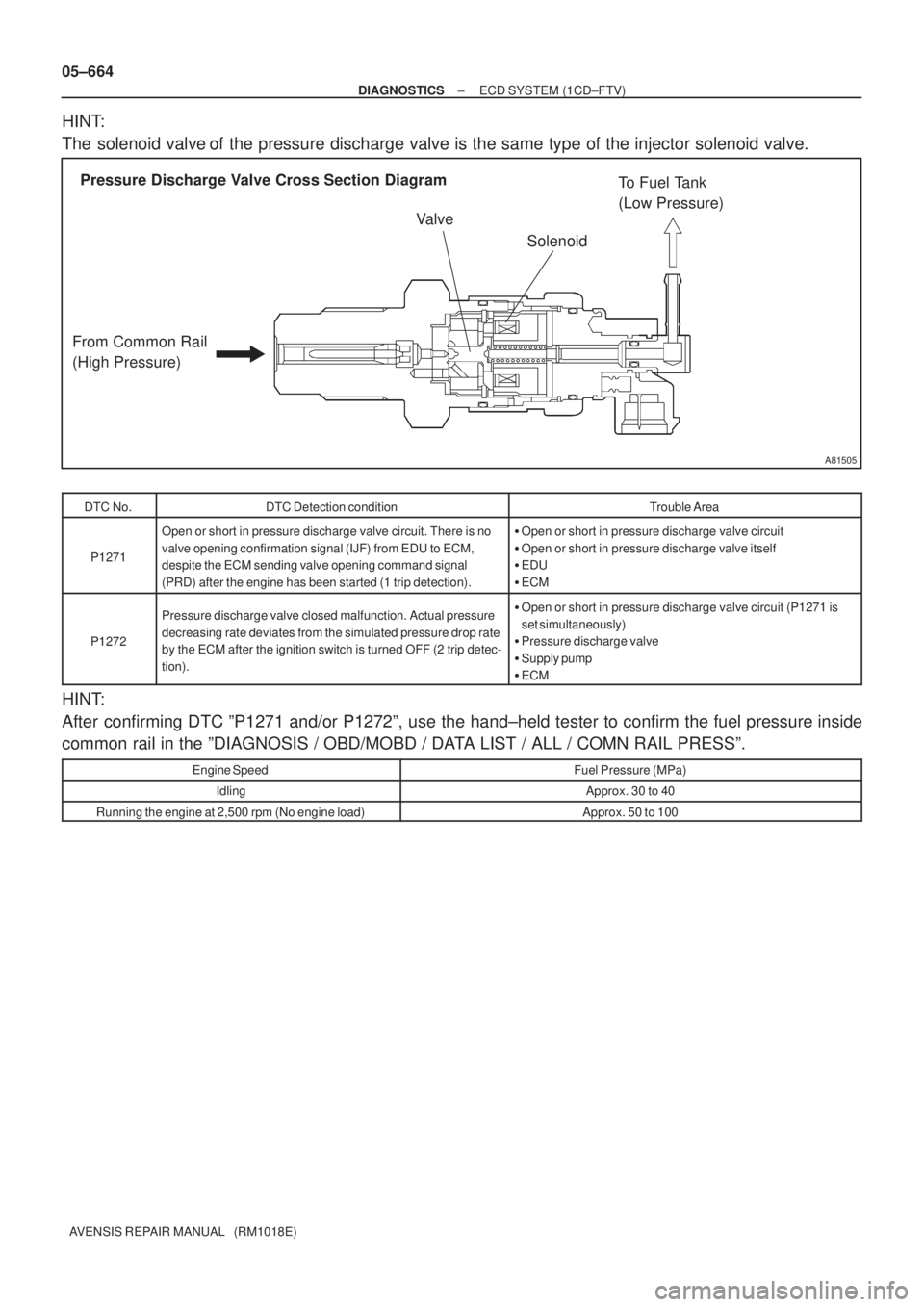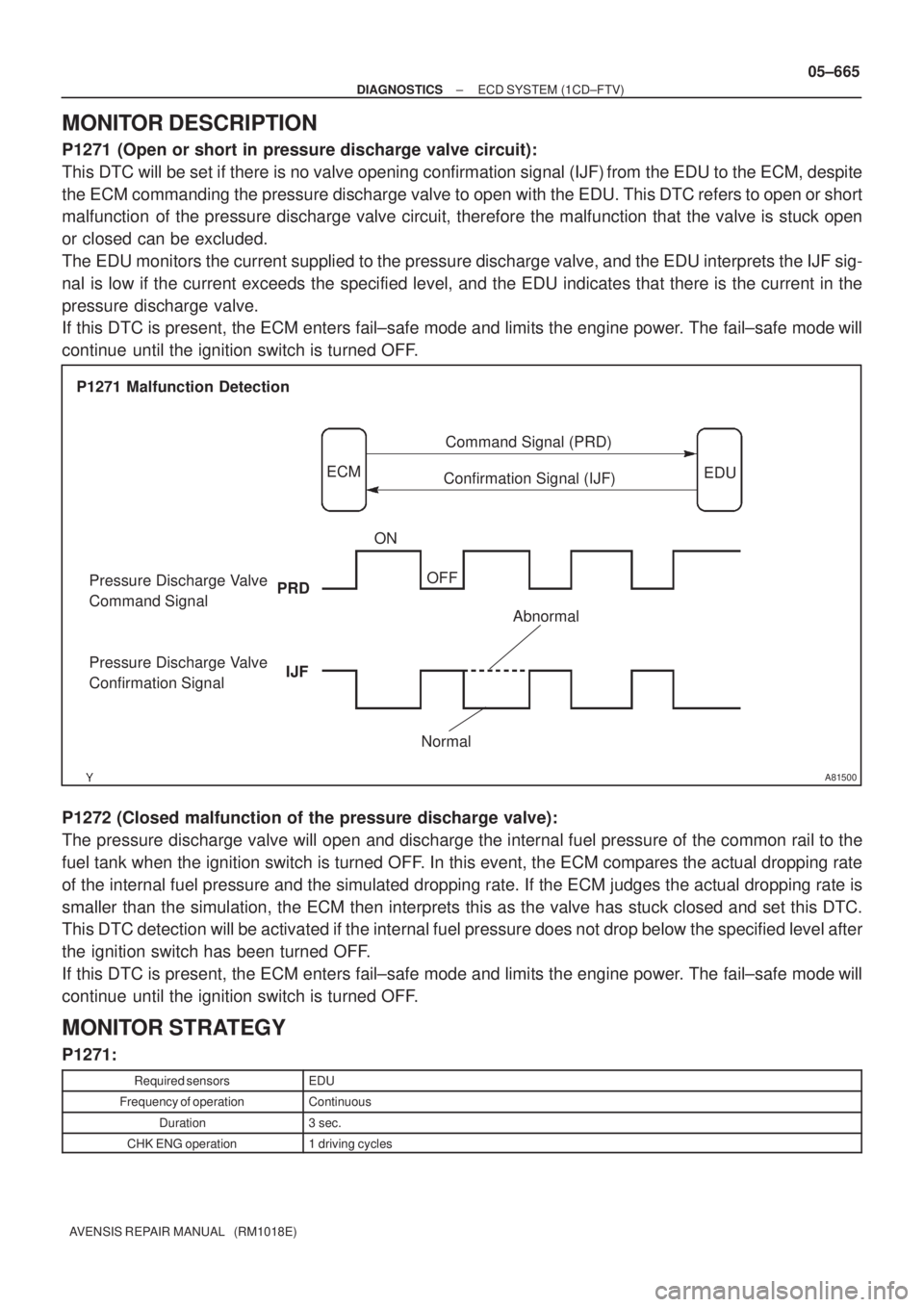Page 738 of 5135

A75743
Fuel Temp. SensorECM
A66104
F18
Wire Harness SideFuel Temp. Sensor Connector
A75742
Fuel Temp. SensorECM
A80450
THFE2
E13
ECM Connector
±
DIAGNOSTICS ECD SYSTEM(1CD±FTV)
05±601
AVENSIS REPAIR MANUAL (RM1018E)
2READ VALUE OF HAND±HELD TESTER(CHECK FOR OPEN IN WIRE HARNESS)
(a)Disconnect the F18 fuel temperature sensor connector.
(b)Connect terminals 1 and 2 of the fuel temperature sensor
wire harness side connector.
(c)Turn the ignition switch ON.
(d)Select the item ºDIAGNOSIS / OBD/MOBD / DATA LIST / ALL / FUEL TEMPº and read its value displayed on the
hand±held tester.
Temperature: 140 �C (284 �F) or more
OKCONFIRM GOOD CONNECTION AT SENSOR. IF OK, REPLACE FUEL TEMPERATURE SENSOR
NG
3READ VALUE OF HAND±HELD TESTER(CHECK FOR OPEN IN ECM)
(a)Disconnect the F18 fuel temperature sensor connector.
(b)Connect terminals THF and E2 of the E13 ECM connec- tor.
HINT:
Before checking, do a visual and contact pressure check for the
ECM connector.
(c)Turn the ignition switch ON.
(d)Select the item ºDIAGNOSIS / OBD/MOBD / DATA LIST / ALL / FUEL TEMPº and read its value displayed on the
hand±held tester.
Temperature: 140 �C (284 �F) or more
OKREPAIR OR REPLACE HARNESS OR CONNECTOR
NG
CONFIRM GOOD CONNECTION AT ECM. IF OK, CHECK AND REPLACE ECM
(See page 10±65)
Page 739 of 5135
A76591
Fuel Temp. SensorECM
A75744
Fuel Temp. SensorECM
A80456
E13
ECM ConnectorTHF
05±602
±
DIAGNOSTICS ECD SYSTEM(1CD±FTV)
AVENSIS REPAIR MANUAL (RM1018E)
4READ VALUE OF HAND±HELD TESTER(CHECK FOR SHORT IN WIRE HARNESS)
(a)Disconnect the F18 fuel temperature sensor connector.
(b)Turn the ignition switch ON.
(c)Select the item ºDIAGNOSIS / OBD/MOBD / DATA LIST / ALL / FUEL TEMPº and read its value displayed on the
hand±held tester.
Temperature: ±40 �C (±40 �F)
OKREPLACE FUEL TEMPERATURE SENSOR
NG
5READ VALUE OF HAND±HELD TESTER(CHECK FOR SHORT IN ECM)
(a)Disconnect the E13 ECM connector.
(b)Turn the ignition switch ON.
(c)Select the item ºDIAGNOSIS / OBD/MOBD / DATA LIST / ALL / FUEL TEMPº and read its value displayed on the
hand±held tester.
Temperature: ±40 �C (±40 �F)
OKREPAIR OR REPLACE HARNESS OR CONNECTOR
NG
REPLACE ECM (See page 10±65)
Page 747 of 5135

±
DIAGNOSTICS ECD SYSTEM(1CD±FTV)
05±685
AVENSIS REPAIR MANUAL (RM1018E)
DTCP2227BAROMETRIC PRESSURE CIRCUIT
RANGE/PERFORMANCE
CIRCUIT DESCRIPTION
Detect the atmospheric pressure using the atmospheric pressure sensor. Followed by the atmospheric pres-
sure, correct the injection timing, the injection volume and the amount of co\
mmon rail internal fuel pressure
and then they create optimum combustion.
DTC No.DTC Detection ConditionTrouble Area
P2227Atmospheric pressure sensor malfunction
(2 trip detection logic)�ECM
INSPECTION PROCEDURE
HINT:
Read freeze frame data using �����\b��������
�� . Freeze frame data records the engine conditions when
a malfunction is detected. When troubleshooting, it is useful for determi\
ning whether the vehicle was running
or stopped, the engine was warmed up or not, etc. at the time of the malfu\
nction.
1CHECK OTHER DTC OUTPUT(BESIDES DTC P2227)
(a)Read the DTC using the hand±held tester. Result:
Display (DTC output)Proceed to
P2227 and other DTCs are outputA
Only P2227 is outputB
HINT:
If any other codes besides P2227 are output, perform the troubleshooting f\
or those DTCs first.
BREPLACE ECM (See page 10±65)
A
GO TO RELEVANT DTC CHART (See page 05±544)
05CQ6±01
Page 748 of 5135
05±684
±
DIAGNOSTICS ECD SYSTEM(1CD±FTV)
AVENSIS REPAIR MANUAL (RM1018E)
DTCP2226BAROMETRIC PRESSURE CIRCUIT
DTCP2228BAROMETRIC PRESSURE CIRCUIT LOW INPUT
DTCP2229BAROMETRIC PRESSURE CIRCUIT HIGH INPUT
CIRCUIT DESCRIPTION
Detect the atmospheric pressure using the atmospheric pressure sensor. Followed by the atmospheric pres-
sure, correct the injection timing, the injection volume and the amount of co\
mmon rail internal fuel pressure
and then they create optimum combustion.
DTC No.DTC Detection ConditionTrouble Area
P2226
P2228
P2229
ECM malfunction (1 trip detection logic)�ECM
INSPECTION PROCEDURE
HINT:
Read freeze frame data using �����\b��������
�� . Freeze frame data records the engine conditions when
a malfunction is detected. When troubleshooting, it is useful for determi\
ning whether the vehicle was running
or stopped, the engine was warmed up or not, etc. at the time of the malfu\
nction.
REPLACE ECM (See page 10±65)
05CQ5±01
Page 757 of 5135

A81485
Fuel Pressure
Pressure Discharge Valve Operation Under Sudden Deceleration
Pressure Discharge Valve w/o Pressure Discharge Valve
Close
Accelerator Pedal
Opening Angle
Open
Close
Open
w/ Pressure Discharge Valve
TargetFuel Pressure TimeLong Time
±
DIAGNOSTICS ECD SYSTEM(1CD±FTV)
05±663
AVENSIS REPAIR MANUAL (RM1018E)
DTCP1271FUEL REGULATOR CIRCUIT MALFUNCTION
(EDU DRIVE)
DTCP1272FUEL PRESSURE REGULATOR MALFUNCTION
HINT:
�For more information on the pressure discharge valve and the common rail sy\
stem, see page 05±517.
�For more information on the EDU, see page 05±604.
�If P1271 and/or P1272 are present, use the diagnostic trouble code matrix for fuel syste\
m, see page
05±517.
CIRCUIT DESCRIPTION
The ECM controls the internal fuel pressure of the common rail by opening a\
nd closing the pressure dis-
charge valve. When sudden deceleration is occurred, the internal fuel pressure will temporarily become
higher than usual and combustion noise may result, therefore the ECM will open the valve temporarily to
discharge the pressure inside the common rail. Also, the pressure discharge valve open\
s when the ignition
switch is turned OFF, and the internal pressure is then promptly discharged.
05CQ1±01
Page 758 of 5135

A81505
Pressure Discharge Valve Cross Section Diagram
From Common Rail
(High Pressure)To Fuel Tank
(Low Pressure)
Valve
Solenoid
05±664
± DIAGNOSTICSECD SYSTEM (1CD±FTV)
AVENSIS REPAIR MANUAL (RM1018E)
HINT:
The solenoid valve of the pressure discharge valve is the same type of the injector solenoid valve.
DTC No.DTC Detection conditionTrouble Area
P1271
Open or short in pressure discharge valve circuit. There is no
valve opening confirmation signal (IJF) from EDU to ECM,
despite the ECM sending valve opening command signal
(PRD) after the engine has been started (1 trip detection).�Open or short in pressure discharge valve circuit
�Open or short in pressure discharge valve itself
�EDU
�ECM
P1272
Pressure discharge valve closed malfunction. Actual pressure
decreasing rate deviates from the simulated pressure drop rate
by the ECM after the ignition switch is turned OFF (2 trip detec-
tion).�Open or short in pressure discharge valve circuit (P1271 is
set simultaneously)
�Pressure discharge valve
�Supply pump
�ECM
HINT:
After confirming DTC ºP1271 and/or P1272º, use the hand±held tester to confirm the fuel pressure inside
common rail in the ºDIAGNOSIS / OBD/MOBD / DATA LIST / ALL / COMN RAIL PRESSº.
Engine SpeedFuel Pressure (MPa)
IdlingApprox. 30 to 40
Running the engine at 2,500 rpm (No engine load)Approx. 50 to 100
Page 759 of 5135

A81500
P1271 Malfunction Detection
ECMCommand Signal (PRD)
EDU
Confirmation Signal (IJF)
Pressure Discharge Valve
Command Signal
Pressure Discharge Valve
Confirmation SignalPRD
IJFON
OFF
Normal
Abnormal
± DIAGNOSTICSECD SYSTEM (1CD±FTV)
05±665
AVENSIS REPAIR MANUAL (RM1018E)
MONITOR DESCRIPTION
P1271 (Open or short in pressure discharge valve circuit):
This DTC will be set if there is no valve opening confirmation signal (IJF) from the EDU to the ECM, despite
the ECM commanding the pressure discharge valve to open with the EDU. This DTC refers to open or short
malfunction of the pressure discharge valve circuit, therefore the malfunction that the valve is stuck open
or closed can be excluded.
The EDU monitors the current supplied to the pressure discharge valve, and the EDU interprets the IJF sig-
nal is low if the current exceeds the specified level, and the EDU indicates that there is the current in the
pressure discharge valve.
If this DTC is present, the ECM enters fail±safe mode and limits the engine power. The fail±safe mode will
continue until the ignition switch is turned OFF.
P1272 (Closed malfunction of the pressure discharge valve):
The pressure discharge valve will open and discharge the internal fuel pressure of the common rail to the
fuel tank when the ignition switch is turned OFF. In this event, the ECM compares the actual dropping rate
of the internal fuel pressure and the simulated dropping rate. If the ECM judges the actual dropping rate is
smaller than the simulation, the ECM then interprets this as the valve has stuck closed and set this DTC.
This DTC detection will be activated if the internal fuel pressure does not drop below the specified level after
the ignition switch has been turned OFF.
If this DTC is present, the ECM enters fail±safe mode and limits the engine power. The fail±safe mode will
continue until the ignition switch is turned OFF.
MONITOR STRATEGY
P1271:
Required sensorsEDU
Frequency of operationContinuous
Duration3 sec.
CHK ENG operation1 driving cycles
Page 760 of 5135
05±666
± DIAGNOSTICSECD SYSTEM (1CD±FTV)
AVENSIS REPAIR MANUAL (RM1018E)
P1272:
Required sensorsFuel pressure sensor
Frequency of operationOnce per driving cycle
Duration1 sec.
CHK ENG operation2 driving cycles
TYPICAL ENABLING CONDITIONS
P1271:
Specification
Drive the vehicle at 50 km/h with the 3 rd transmission gear and then decelerate it by completly releasing the accelerator pedal
P1272:
ItemSpecificationItemMinimumMaximum
Fuel pressure30 MPa (306 kgf/cm2, 4,351 psi)±
Fuel temperature0�C±
Battery voltage11 V±
The monitor will not run if the fuel pressure sensor, or pressure discharge valve circuit, or fuel temp. sensor is malfunctioning
TYPICAL MALFUNCTION THRESHOLDS
P1271:
Threshold
If the confirmation signals from the EDU is not present, despite the ECM sending the command signals regularly during decelerating
P1272:
Threshold
If the internal pressure stays beyond the specified level after the ignition switch was turned OFF